When the bluestreak cleaner wrasse (Labroides dimidiatus) cleans another fish to remove its parasites, it also increases their cognitive performance according to new research
Cleaner wrasses (Labroides sp.) are a type of fish that lives in symbiosis with other fish by eating parasites from their skin. The recipient of the grooming service provided by the cleaner wrasses are typically larger, often predatory fish that has a lot of surface area that needs cleaning.
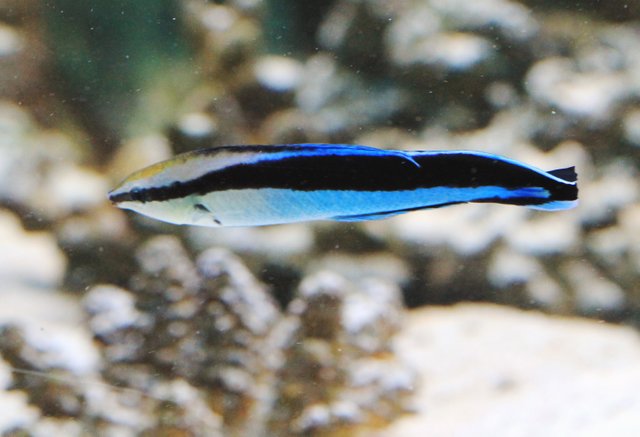
Bluestreak cleaner wrasse. Image by Karelj, posted with the Creative Commons Attribution-Share Alike 3.0 Unported license.
It is a really cool symbiosis, and the cleaner wrasses even have their own cleaning stations where the recipient fish swim to in order to get its skin cleaned. What happens is that the cleaning fish will eat and consume both dead tissue, old scales and ectoparasites – parasites that are living on the outside of an organism.
A single cleaner wrasse can consume about 1,000 parasites from its client each day, but smaller individuals tend to eat less. This is however counterweighted by the fact that a single cleaning station can host several small individuals, such as a family group, or a pair of sub-adult fish that would not be able to clean an entire client by itself.
The most common cleaner wrasse is the bluestreak cleaner wrasse (Labroides dimidiatus), a fish that is found in coral reefs from Eastern Africa all the way to the Red Sea, and to French Polynesia. This is also the species that was used for the study that I wrote about in the title, and that we will soon take a closer look at.
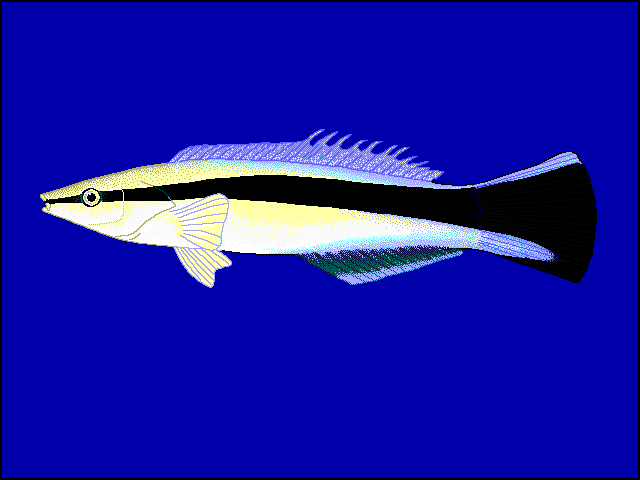
A bluestreak cleaner wrasse. The sketch is Public Domain.
And for the record, there are also other fish that have specialized in cleaning parasites from bigger fish, but the cleaner wrasses are the most abundant ones, and the only ones we will go into detail about in today’s post.
How come the cleaner wrasses are not being eaten by the clients?
A question that actually puzzled scientists for a little while is why the cleaner wrasses were not being eaten when they were approaching the client before beginning the grooming. The current theory is that the cleaning wrasses are recognized by their big, black lateral stripe that goes across all of its body, in addition to the fact that it makes a small “dance” to greet the client before beginning the cleaning service.
I would also assume that there have been a long time with co-evolution where the cleaner wrasses have gradually evolved alongside the clients in order for them both to have evolved into accepting this behavior. This also allowed some other fish to mimic the cleaner wrasses, such as the bluestriped fangblenny (Plagiotremus rhinorhynchos) that mimic juvenile cleaner wrasses. This guy does not clean at all, but once he gets close to a “client”, he rather takes a bite out of their skin instead of cleaning it.
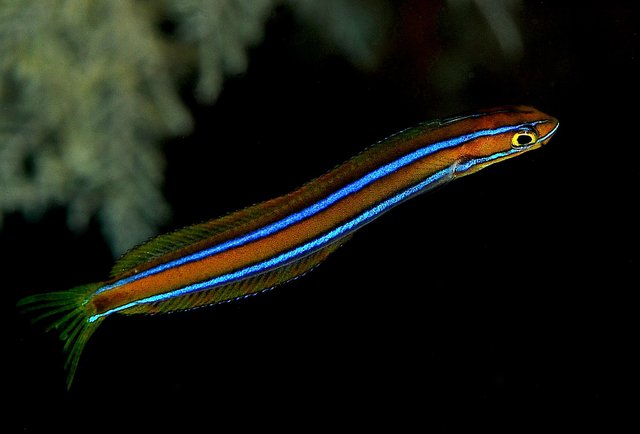
A bluestriped fangblenny, one of the fish that mimic the cleaner wrasse. Image by Jenny Huang, posted with the Creative Commons Attribution 2.0 Generic license.
Another species that mimics the cleaner wrasses are the false cleanerfish (Aspidontus taeniatus). These fish looks almost exactly like the bluestreak cleaner wrasse, and are believed to have evolved this mimicry to avoid predation.
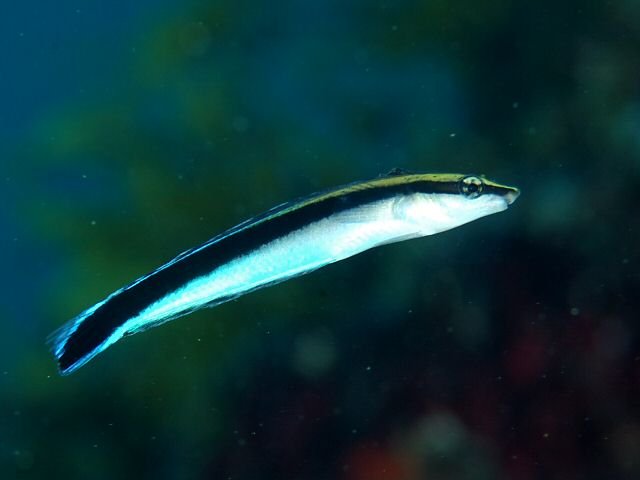
A false cleanerfish. Image by Izuzuki, posted with the Creative Commons Attribution-Share Alike 2.5 Generic license.
The clients are most likely getting smarter when being cleaned!
Since the cleaner wrasses removes about a thousand parasites a day, they obviously expected there to be some differences, including a shorter expected life span for the ones who did not receive cleaning, but they also found some very interesting and unexpected results.
One key finding is that the client fish without cleaners also had a lot more internal parasites, but this also makes sense when you think about it. When the fish have to fight parasites on two fronts at the same time, they cannot afford to allocate as much energy to each front, and thus they have a higher concentration of internal parasites.
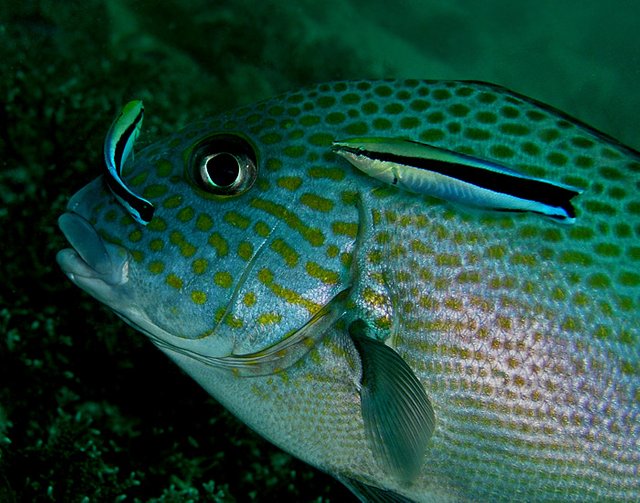
Two cleaner wrasses with a client. Image by Nhobgood, posted with the Creative Commons Attribution-Share Alike 3.0 Unported license.
The coolest finding was still that the fish who received cleaning from the cleaner wrasses scored better on an intelligence test. The researchers had a total of three different intelligence test, and the first two were easy match for both the cleaned and the uncleaned group. However, the third test was pretty complex, and was based on teaching the fish to associate an image with food. By selecting the correct image they would get a piece of food, so this was not easy for the fish to learn.
The researchers learned that the group that had not been cleaned by the cleaner wrasses scored a lot worse on this test compared to the group that had been receiving cleaning! This could very well mean that fish and organisms that are infected by many parasites have a more difficult time to learn complex tasks.
The hypothesis as to why they are dumber is because they had to spend more energy on removing parasites and fighting parasite attacks, so they had much less energy to spend on the learning tasks.
It is absolutely a pretty interesting thing to be able to find and document, and it might actually have some appliances in real-life once we figure out more of this. It might even be transferable to humans who live in conditions with a lot of exposure to parasites, and might be something we should take a closer look at if we want to keep educating the world.
Thanks for reading
I hope you enjoyed the post. The sources are scattered in the relevant part of the text, but make sure to click on some of them if you want to learn more about these cool fish!
About @valth
Hey, I'm @valth - the author of this post. I love to write about nature, biology, animals, nature conservation, ecology and other related branches of science, and I occasionally write about my life, about Steem or about random stuff as well. I'm trying my best to write at least one post every day, so make sure to give me a follow if you enjoy my content and want to see more of it.
Join the @valth community!
I love nothing more than to engage with my readers, so please join the @valth community in the comment section. You will definitely find more information about the topic, personal experiences, questions, and even opposing views down there, so don't miss out on learning more.
I always reward users who post good comments, so please take the opportunity to share your views and get a small upvote in exchange for it.
Hi @Valth
A friend of mine have a huge saltwater aquarium and has a couple of these blue streak cleaners. The funny thing about them is that when you put your hand into the tank, the swim up and clean it and it tickles :)
Once a gain an interesting article from you.
That's a great story! I actually read that they are apparently very difficult to keep alive in an aquarium, so your friend must be pretty skilled to keep them :)
I had been wondering if any cheaters had evolved, since that's an interest of mine, and was gearing up to google mid-article, then saw the paragraph on the fangblenny (which is a wonderful name!). Well-anticipated!
For those who are interested, this form of behavior is known as Batesian mimicry (though it's more popularly associated with benign species co-opting the markings of a poisonous or venomous one). They're an interesting system - sometimes they occur in regions without the 'real deal', we wonder why they aren't all that perfect, and (my personal interest) we wonder what %of the population can be mimics without the whole thing falling apart (the first link suggests 100% in some cases!)
Thanks for leaving a valuable comment, @effofex!
Batesian mimicry is indeed an interesting topic, especially when combined with game theory. It makes a lot of sense that some organisms do evolve to cheat the other organisms who have evolved a (sometimes very costly) trait to do something useful such as preventing predators from eating them.
Best regards from @valth
Great post! :)
They are interesting little guys for sure, I've been tempted to add one to my Reef aquarium for a while but have always been put off by the fact I would not be able to replicate their diet in the wild.
The black lateral line is also a signature of the small family of Neon Gobies (Elacatinus), they too act as parasitic cleaners in the wild, it may just be coincidental, but it is interesting nonetheless.
Thanks!
I read that they were apparently very difficult to keep in a fish tank, especially for longer than a few months. I didn't read too much about keeping them in captivity, but it seemed like a pretty difficult task.
And thanks for posting about the neon gobies. I didn't realize that these too have a black lateral line, but it's really interesting to learn that this is a shared trait for cleaner fish species. I wonder if this is just random, or if these lines have evolved as a biological marker to tell the "clients" that these are in fact cleaner fish.
I could not help myself. I needed to know what that little 'dance' looks like. And it is as adorable as I thought XD
Oh yeah, you are right! That looks really adorable :)
Beautiful cleaning service providers....
And the findings of the intelligence test were surprising. The fact that other fish mimic their behavior and appearance for the survival is amazing.
oh my God, these fishes are very strange for me. ewwwwwwww
Yeah, they are extremely strange and unique :)
What an interesting post, every time I read a publication of yours I learn something new, please keep posting here you have a faithful follower who always reads you, about the post it seems incredible to me as nature and animals can surprise us in very peculiar ways! AMAZING
Thank you! Don't worry - I will absolutely keep posting for the foreseeable future ;)
Very nice kind friend excellent and interesting post I learned things that I did not know thank you and I invite you to lean on my blog greetings
I'm glad you learned something new from reading the post :)
Indeed an informative post for non-bio students like me.
I'm glad you found it informative :)
Very nice kind friend excellent and interesting post I learned things that I did not know thank you and I invite you to lean on my blog greetings
I'm glad you learned some new things :)